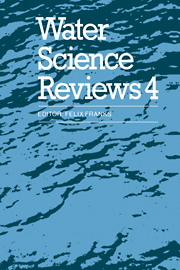Hydration of surfaces with particular attention to micron-sized particles
Published online by Cambridge University Press: 03 February 2010
Summary
Preamble
The interaction of solid materials with water is clearly of profound and vast scientific and technological importance. The range of areas where such understanding is important is so large as almost to defy listing. A highly incomplete but hopefully representative list might include mineral separation, electrodes, sensors and membranes, biocompatibility of non-biological material, geochemistry and weathering, oil recovery, archaeological dating, particle toxicology, composites and new materials, corrosion, cement and concrete, ice nucleation and meteorology, protein and biological assembly structure and stability, frost heaving, colloid stability, etc., etc.
In many ways study of the heterogeneous systems has mirrored that of homogeneous analogues; in particular we may note that solute–solute (homogeneous) and solute–surface (heterogeneous) studies have taken precedence over solute–solvent (homogeneous) and surface–solvent (heterogeneous) studies. The reasons for this are two-fold: firstly, relatively successful primitive electrostatic models for both homogeneous (Debye– Hiickel) and heterogeneous (Gouy–Chapman–Stern) systems exist which do not require explicit treatment of the solvent beyond it being a dielectric continuum. Second, the study of both surface–solvent and solute–solvent interactions has been somewhat restricted by the limited range of experimental techniques available, although gas-surface study is very much a long-established research area. We mention in passing that relatively recently gas phase ion solvation studies have shed much light on the homogeneous systems.
The very large potential scope of this review implies that a certain number of topics of great relevance to the subject will not be discussed or will be given only passing mention.
- Type
- Chapter
- Information
- Water Science Reviews 4Hydration Phenomena in Colloidal Systems, pp. 127 - 172Publisher: Cambridge University PressPrint publication year: 1989

